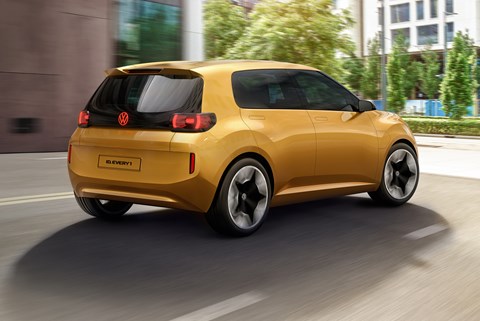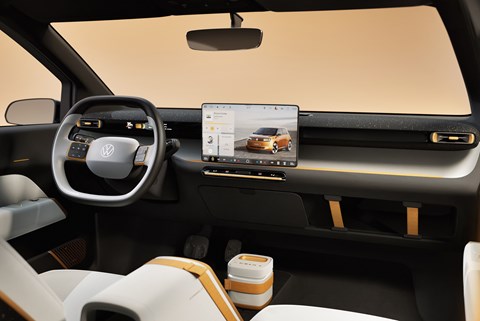► VW’s ID. Every1 concept car revealed
► Our first look at a £17k EV due in 2027
► A new European EV bargain?
Say hello to what could become your child’s first car. Polo, Golf and Beetle before those two… Volkswagen has had more of a hand than most in getting people into their first car and the company is hoping that the ID. Every1 concept it’s just unveiled will be the blueprint for more of the same.
It’s difficult to overstate how important this car is to Volkswagen. This concept previews what will be an actual car in 2027, where the production ID. 1 will become the starting point to VW’s electric range and should begin at just £17,000. In an era when we’re all singing the praises of the Renault 5 for kicking things off at £22,995, that is quite some bargain.
How has VW managed it?
The ID. Every1 is slightly smaller, admittedly, than an R5; it’s more a four-seat city car following on from the Lupo and e-Up. Front-wheel drive, the car sits on the same MEB platform that will underpin the ID. 2 models but the key to the price point is ever better technology and economies of scale.

Thomas Schäfer, boss of VW, recently told me that ‘as electrification progresses and the work on the battery cells, the chemistry and the formats have progressed… you get a real trajectory for the battery cost that enables small car electrification.
‘You need scale for it, in order to get it done… To get a business case going, you need numbers and you technology that you can scale.’
Not that it’s all plain sailing. ‘If you look at it only from profit maximisation, walk away from it [the city car EV]. I’d rather do large SUVs.’
Despite this, there aren’t any current plans for either Seat, Cupra or Skoda to build their own version of the ID. 1. Clearly there’s flexibility. Volkswagen’s chief technical officer, Kai Grünitz, explained that VW didn’t plan for the ID. 1 to rely on very high volumes but rather to build in adjustability depending on how the market is going. If people want more ID. 2s, they can build more of them – the factories can be tailored to suit.
There are clever design touches that keep costs low, like the lack of any additional body cladding or the way the rear door is made from a single piece of sheet metal. Design boss Andreas Mindt told me that he wants to ‘turn affordable into beautiful’.
Any performance numbers at this stage?
A few. VW promises that the concept can reach 80mph and is powered by a new electric motor that produces 94bhp, with a range of over 155 miles. It’s very much a city car that could just about keep up on the motorway.

Size-wise, it sits between the Up and current Polo, with VW promising enough room for four adults (not unrealistic, given the packaging advantages that an EV brings) and a boot volume of 305 litres. To put that in context, the current Mini Cooper E has 210 litres.
A new software architecture is promised, crucial in allowing the production ID. 1 to continue to develop through its life cycle. This is where the joint venture with Rivian will start to bear fruit, where Volkswagen taps into the US manufacturer’s software knowledge and its ability to control more of the car from one central brain, a bit like BMW’s Heart of Joy. Grünitz, talks of a zonal electronic architecture that is scalable depending on the sort of model it’s fitted to – a basic ID. 1 might get just the one zone, the ID. 7 more like three. The point is that it’s entirely flexible and comes from the same starting point, so VW doesn’t have to start the process all over again each time a new model is launched.
Still a boring name, though…
It’s not quite clear yet as to what the production car will be called. The ID. Every1 name is just for the concept and the senior team at VW have recently been suggesting that the ID name could be retired in favour of the brand’s more famous badges, such as Golf, Polo and Up. Whether this is the car to make that transition remains unclear.
What is clear, though, is that it’s part of a VW renaissance under Schäfer: nine new models are promised by 2027 and we should see the production version of the Polo-sized ID. 2 later in 2025.
2025: why it’s fast becoming the year of the cheap(er) EV